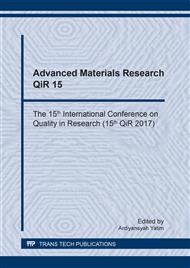[1]
J. Jaguemont, L. Boulon, Y. Dubé, A comprehensive review of lithium-ion batteries used in hybrid and electric vehicles at cold temperatures, Applied Energy, 164 (2016) p.99–114.
DOI: 10.1016/j.apenergy.2015.11.034
Google Scholar
[2]
M.M. Zhong and Z.T. Zhou, Effect of Reactant Phase form on the Properties of LiFePO4 Synthesized by Carbothermal Reduction Method, Solid State Ionics, 181 (2010) pp.1607-1610.
DOI: 10.1016/j.ssi.2010.09.015
Google Scholar
[3]
D. Wang, The Influence of the TiO2 Particle Size on the Properties of Li4Ti5O12 Anode Material for Lithium-Ion Battery, Ceramics International, 40 (2014) pp.3799-3804.
DOI: 10.1016/j.ceramint.2013.09.038
Google Scholar
[4]
S.Y. Chung, J.T. Bloking, Y.M. Chiang, Electronically Conductive Phospho-Olivines as Lithium Storage Electrodes, Nature Materials, 1 (2002) pp.123-128.
DOI: 10.1038/nmat732
Google Scholar
[5]
A. S. Andersson and J. O. Thomas, The Source of First-Cycle Capacity Loss in LiFePO4, Journal of Power Sources, 97 (2001) p.498–502.
DOI: 10.1016/s0378-7753(01)00633-4
Google Scholar
[6]
D. Arumugam, G.P. Kalaignan, and P. Manisankar, Synthesis and electrochemical characterizations of nano-crystalline LiFePO4 and Mg-doped LiFePO4 cathode materials for rechargeable lithium-ion batteries. Journal of Solid State Electrochemistry, 13 (2008).
DOI: 10.1007/s10008-008-0533-3
Google Scholar
[7]
A. Väyrynen and J. Salminen, Lithium Ion Battery Production. Journal of Chemical Thermodynamic, 46 (2012) p.80 – 85.
Google Scholar
[8]
J. Wang, Z.B. Shao, H.Q. Ru, Influence of Carbon Sources on LiFePO4/C Composites Synthesized by the High-Temperature High-Energy Ball Milling Method, Ceramics International, 40 (2014) p.6979–6985.
DOI: 10.1016/j.ceramint.2013.12.025
Google Scholar
[9]
S. M. Zheng, X. Wang, X. Huang, C.H. Liu, Hydrothermal Synthesis of Ni-Doped Carom-Like LiFe0.95Ni0.05PO4 Powders, Ceramics International, 38 (2012) p.4391–4394.
DOI: 10.1016/j.ceramint.2012.01.025
Google Scholar
[10]
T. Honma, K. Nagamine, T. Komatsu, Fabrication of Olivine-Type LiMnxFe1-xPO4 Crystals via the Glass–Ceramic Route and Their Lithium Ion Battery Performance, Ceramics International, 36 (2010) p.1137–1141.
DOI: 10.1016/j.ceramint.2009.10.003
Google Scholar
[11]
Y.H. Ding and P. Zhang, Effect of Mg and Co Co-Doping on Electrochemical Properties of LiFePO4, Transaction of Nonferrous Metal Society of China, 22 (2012) pp. s153–s156.
DOI: 10.1016/s1003-6326(12)61701-4
Google Scholar
[12]
Nixon, D. E., Parry, G. S., and Ubbelohde, A. R., Order-Disorder Transformations in Graphite Nitrates, Proceeding of the Royal Society of London A, 291 (1966) pp.324-339.
Google Scholar
[13]
Yang, M.R., and Ke, W.H., The Doping Effect on the Electrochemical Properties of LiFe0.95M0.05PO4 (M = Mg2+, Ni2+, Al3+, or V3+) as Cathode Materials for Lithium-Ion Cells Batteries and Energy Storage. Journal Electrochemical Society, 155 (2008).
Google Scholar
[14]
Teng, T.H., Yang, M.R., Wu, S.H., Electrochemical Properties of LiFe0.9Mg0.1PO4/carbon Cathode Materials Prepared by Ultrasonic Spray Pyrolysis, Solid State Communications, 142 (2007) pp.389-392.
DOI: 10.1016/j.ssc.2007.03.010
Google Scholar
[15]
Franger, S., Le Cras, F., Bourbon, C., Rouault, H., Comparison Between Different LiFePO4 Synthesis Routes and Their Influence on Its Physico-Chemical Properties, Journal of Power Sources, 119-121 (2003) pp.252-257.
DOI: 10.1016/s0378-7753(03)00242-8
Google Scholar
[16]
Yang, X., Hu, Z., and Liang, J., Effects of Sodium and Vanadium Co-Doping on the Structure and Electrochemical Performance of LiFePO4/C Cathode Material for Lithium-ion Batteries. Ceramics International, 41 (2015) pp.2863-2868.
DOI: 10.1016/j.ceramint.2014.10.108
Google Scholar
[17]
Shu, H., Wang, X., Wu, Q., Liang, Q., Yang, X., Yang, S., Liu, L., Wei, Q., Hu, B., Zhou, M., Chen, M., and Zhang, L., Enhancement of Electrochemical Properties for Monodisperse Spherical LiFePO4/C Synthesized by Ammonia Assisted Hydrothermal Route via Ni and F Co-Doping, Journal of The Electrochemical Society, 159 (2012).
DOI: 10.1149/2.002212jes
Google Scholar
[18]
Bearden, J. A., X-Ray Wavelengths, Review of Modern Physics, 39 (1967) pp.86-99.
Google Scholar
[19]
Sofyan, N., Putro, D. Y., and Zulfia, A., Performance of Vanadium-Doped LiFePO4/C Used as Cathode for Lithium Ion Battery, International Journal of Technology, 7 (2016) pp.932-9406.
DOI: 10.14716/ijtech.v7i8.6893
Google Scholar
[20]
Zhang, L.-L., Liang, G., Ignatov, A., Croft, M. C., Xiong, X.-Q., Hung, M., Huang, Y.-H., Hu, X.-L., Zhang, W.-X., and. Peng, Y.-L., Effect of Vanadium Incorporation on Electrochemical Performance of LiFePO4 for Lithium-Ion Batteries, Journal of Physical Chemistry, 20 (2011).
DOI: 10.1021/jp2034906
Google Scholar


